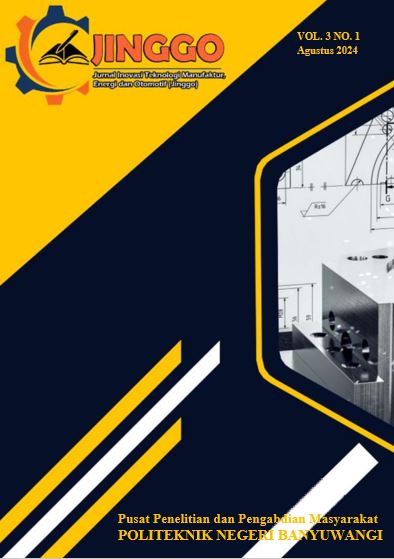IDENTIFIKASI BAHAYA DAN RISIKO PEMASANGAN TANGKI RESERVOIR GLASS FUSED STEEL TANK PT. XYZ
DOI:
https://doi.org/10.57203/jinggo.v3i1.2024.17-24Abstract
Perusahaan swasta nasional PT. XYZ bergerak di bidang pertambangan, teknologi industri, serta konstruksi. Salah satu proyek yang dijalankan adalah pemasangan tangki reservoir glass fused steel tank (GSFT). GSFT yang dipasang ini merupakan tangki reservoir dengan menggabungkan kekuatan dan fleksibilitas baja dan ketahanan korosi kaca. Pada proses pekerjaan pada suatu industri pasti akan menimbulkan bahaya dan risiko. Penelitian ini bertujuan untuk mengidentifikasi risiko potensial dan menilai kemungkinan terjadinya kesehatan dan keselamatan kerja, serta mengevaluasi efektivitas langkah-langkah pengendalian risiko. Identifikasi potensi bahaya dan penilaian risiko selanjutnya akan dilakukan melalui penggunaan pendekatan Hazard and Operability Study (HAZOP) didapatlah hasil bahwa kategori risiko masih dalam kategori sedang dan hanya 1 aktivitas saja yang termasuk kategori berat. Pengendalian risiko yang dilakukan bisa meminimalisir tingkat risiko menjadi kategori kecil.
References
[1] Kementerian Ketenagakerjaan Indonesia. 2024. Data Kecelakaan Kerja Indonesia. [On-line]. Available: https://satudata.kemnaker.go.id/ [August 10, 2003].
[2] Irzal. Dasar-Dasar Kesehatan dan Keselamatan Kerja. Kencana: Jakarta, 2016.
[3] Cici, et.al. Keselamatan dan Kesehatan Kerja. PT. Global Eksekutif Teknologi : Padang. 2022.
[4] Satoto, H.F. “Perspektif Safety Leadership dalam Peningkatan Kinerja Keselamatan Kerja.” Heuristic. DOI : 10.330996/he.v17i1.3571. 2020
[5] ISO 45001. Occupational Health and Safety Management Systems Requirements with Guidance for Use. BSI Standard Limited : London. 2018
[6] Reese, CD. Occupational Safety and Health : Fundamental Principles and Philosophies. 1993, pp. 1-82.
[7] Tahsinul A, et.al. “Analisis Identifikasi Potensi Bahaya Keselamatan dan Kesehatan Kerja (K3) Pabrik Tahu CNG Kota Solok Tahun 2023.” Jurnal Public Health, Volume 10 Nomor 2 hal. 41-51, 2023
[8] Heinrich, H.W. Industrial Accident Prevention : A Scientific Approach. McGraw-Hill :New York. 1931.
[9] Geler, E. Scoot. The Pshycology of Safety Handbook. Lewis Publisher : London. 2001.
[10] B, Sarah, et. Al. “ Workplace Biological Risk Assessment : Review of Existing and Description of Comprehensive Approach.” Atmosphere, Vol. 11., hal 1-21, 2020, DOI : 10.3390/atmos11070741.
[11] Karwowski, W and William S. Marras. The Occupational Ergonomics Handbook. The Ohio State University : Colombia. 2006
[12] Riyanti, et. al. Manajemen Risiko. Eureka Media Aksara : Purbalingga. 2023.
[13] Kenton, W. “ Risk Control : What It Is, How it Works, Example.” Internet : https://www.investopedia.com/terms/r/risk-control.asp, [13 Agustus 2024].
[14] Artur de J Penelas and Jose C.M. Pires. “HAZOP Analysis in Terms of Safety Operations Process for Oil Production Units: A Case of Study.”Appl. Sci, Vol. 11., 1-17 pp, 2021. DOI : 10.3390/app112110210.
[15] Crawley, F., Preston, M., & Tyler, B. HAZOP: Guide to Best Practice. Institution of Chemical Engineers (IChemE). ISBN 978-0852955253. 2015.
Downloads
Published
Issue
Section
License
Authors who publish with this journal agree to the following terms:
- Authors retain copyright and grant the journal right of first publication with the work simultaneously licensed under a Creative Commons Attribution License that allows others to share the work with an acknowledgement of the work's authorship and initial publication in this journal.
- Authors are able to enter into separate, additional contractual arrangements for the non-exclusive distribution of the journal's published version of the work (e.g., post it to an institutional repository or publish it in a book), with an acknowledgement of its initial publication in this journal.
- Authors are permitted and encouraged to post their work online (e.g., in institutional repositories or on their website) prior to and during the submission process, as it can lead to productive exchanges, as well as earlier and greater citation of published work (See The Effect of Open Access).







